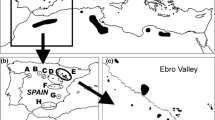Summary
The bill shape of foliage-gleaning birds in temperate and tropical new world forests is dissimilar. Tropical species have longer and narrower bills than their temperate zone counterparts. In addition, their bills are longer for a given body size. These differences cannot be readily explained as phylogenetic artifacts. I suggest that the distinct bill morphology of the two assemblages is determined by the type of insects that comprise the largest size classes of potential prey. These large insects are particularly important since they generally comprise the bulk of the nestling diet for insectivorous birds. In tropical forests Orthoptera are probably the most abundant large soft-bodied arthropods; they form an important resource for foliage-gleaning birds during the breeding (rainy) seasons. Most temperate zone foliage-gleaning birds rely almost entirely upon caterpillars when breeding. Long, narrow bills are thought to close more rapidly than shorter, broader bills. These long, “fast” bills may be required to efficiently harvest active Orthoptera. Migrant warblers may face morphological constraints from breeding successfully in lowland tropical forests. While the short-billed temperate zone birds can survive the tropical dry season by foraging on small arthropods, they may be inefficient at handling large Orthoptera to feed to nestlings.
Similar content being viewed by others
References
Ashmole NP (1968) Body size, prey size and ecological segregation in five sympatric tropical terns (Aves: Laridae) Syst Zool 17:292–304
Beecher WJ (1962) The bio-mechanics of the bird skull. Bull. Chicago Acad Sci 11:10–33
Betts MM (1955) The food of titmice in oak woodlands. J Anim Ecol 24:282–323
Faaborg J (1977) Metabolic rates, resources and the occurrence of non-passerines in terrestrial avian communities. Am Nat 111:903–916
Ficken M, Ficken R, Morse D (1968) Competition and charcter displacement in sympatric pine-dwelling warblers. Evol 22:307–314
Fretwell S (1972) Populations in a seasonal environment. Monogr Pop Biol No 6 Princeton, Princeton Univ Press NJ
Gradwohl J, Greenberg R. The breeding season of antwrens on Barro Colorado Island. In: E Leigh, AS Rand and D Windsor (eds) The ecology of a tropical forest: seasonal rhythms and long-term changes. Smithsonian Press, Washington, DC (in press)
Greenberg R (1980) Body size, breeding habitat, and winter exploitation systems in Dendroica. Auk 96:756–766
Greenberg R, Gradwohl J (1980) Leaf surface specialization in birds and arthropods in a Panamanian forest. Oecologia (Berl) 46:115–124
Heinrich B Foraging strategies of caterpillars: leaf damage and possible predator avoidance strategies. Oecologia (Berl) 42:332–337
Hespenheide H (1975) Prey characteristics and predator niche widths. In: ML Cody and J Diamond (eds), Ecology and evolution of communities. Belknap Press of Harvard Univ. Press, Cambridge, Mass. and London, England, pp 158–181
Holmes RT, Bonney RE, Pacala SW (1979) Guild structure of the Hubbard Brook bird community: a multivariate approach. Ecology 60:512–520
Holmes RT, Schultz SC, Nothnagle P (1979) Bird predation on forest insects: an exclosure experiment. Science 206:462–463
Holmes RT, Sturges FW (1975) Bird community dynamics and energetics in a northern hardwood ecosystem. J Anim Ecol 44:175–200
Janzen DH (1973) Sweep samples of tropical foliage insects: effects of seasons, vegetation types, elevation, time of day, and insularity. Ecology 54:687–708
Janzen DH, Schoener TW (1968) Differences in insect abundance and diversity between wetter and drier sites during a tropical dry season. Ecology 49:96–110
Karr JR (1971) Structure of avian communities in selected Panama and Illinois habitats. Ecol Monogr 41:207–233
Karr JR, James FC (1975) Eco-morphological configurations and convergent evolution in species communities. In: ML Cody and J Diamond (eds) Ecology and evolution of communities. Cambridge, Mass. and London, England, Belknap Press of Harvard Univ. Press. pp 258–292
Lederer R (1975) Bill size, food size and jaw forces of insectivorous birds. Auk 92:385–387
Lederer R (1980) Prey capture by flycatchers and the importance of morphology to behavior. Sociobiology 5:43–46
Morton ES (1980) Adaptation to seasonal changes by migrant landbirds in the Panama Canal Zone. In: A Keast and ES Morton (eds) Migrant birds in the Neotropics: ecology, behavior, distribution, and conservation. Smithsonian Press, Washington DC, pp 437–453
Newton I (1967) The adaptive radiation and feeding ecology of some British finches. Ibis 109:33–98
Nolan V (1979) Ecology and behavior of Dendroica discolor. A.O.U. Ornithological Monogr No 20
Oniki Y (1975) The behavior and ecology of Slaty Antshrike (Thamnophilus punctatus) on Barro Colorado Island, Panama Canal Zone An Acad Brasil Cienc 47:477–514
Ricklefs RE (1977) A discriminant function analysis of assemblages of fruit-eating birds in Central America Condor 79:228–231
Ricklefs RE, Travis J (1980) A morphological approach to the study of avian community organization. Auk 97:211–222
Root R (1967) The niche exploitation pattern of the Blue-gray Gnatcatcher. Ecol Monogr 37:317–350
Royama T (1967) Factors governing the feeding rate, food requirements and brood size of nestling Great Tits Parus major. Ibis 108:313–348
Schoener TW (1965) The evolution of bill size differences among sympatric congeneric species of birds. Evol 19:189–213
Schoener TW (1971) Large-billed insectivorous birds: a precipitous diversity gradient. Condor 73:154–163
Skutch A (1949) Do tropical birds rear as many young as they can nourish? Ibis 91:436–458
Author information
Authors and Affiliations
Rights and permissions
About this article
Cite this article
Greenberg, R. Dissimilar bill shapes in new world tropical versus temperate forest foliage-gleaning birds. Oecologia 49, 143–147 (1981). https://doi.org/10.1007/BF00349180
Received:
Issue Date:
DOI: https://doi.org/10.1007/BF00349180




